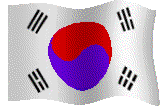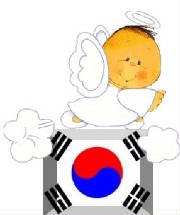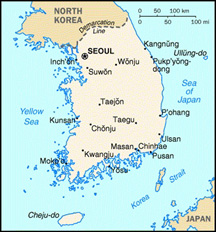|

The Korean name for Korea is "Hangeuk" and its people are called
"Hangeuksaram." The ancient name for Korea is "Choson," which means literally, "the land of morning calm" and
comes from the "Choson" (or "Yi") dynasty of Korea's history (1392 - 1910) during which westerners had their first contact
with Korea.
The national anthem of Korea is "Aeguk Ka" ("Love of Country"). It
was written during the Japanese occupation of Korea (circa 1910 - 1945) and was later set to music by Ahn Eak Tai.
Click here for national anthem!

"The Korean flag is called Taeguk-ki" and was adopted in August of 1882, not long after the "Hermit Kingdom"
opened its front and back doors to foreign aggressive powers. The central theme of the flag is that although there is
constant movement within the sphere of infinity, there is also balance and harmony. The flag consists of three parts:
a white field (or background), a red and blue circle in the center of the flag (containing a "yin-yang" like symbol) and four
black trigrams surrounding the circle in each of the four corners of the flag.
The circle
in the center is called "Taeguk" and means the origin of all things in the universe. The red and blue paisleys within the
circle represent eternal duality (heaven-earth, fire-water, good-evil, male-female, dark-light, life-death). The
blue portion of the circle is called "Um" and presents the negative aspects of this duality; the red portion of the circle
is called "Yang" and represents the positive aspects. "Um-Yang" is the Korean equivalent of "Yin-Yang."
The four black trigrams
come from the Chinese book of "I Ch'ing." The trigrams also carry the idea of opposites and of balance. Each trigram
(or "gye") consists of three parallel lines, some of which are broke (split), and some of which are unbroken (solid).
Each gye has a specific name and represents one or more concept.
In the upper left hand
corner is "K'un" which consists of all solid lines and represents heaven, east and spring.
In the lower
right hand corner is "K'on" which consists of all broken lines and represents earth, west and summer.
In the upper right hand corner is "Kam" which consists of one solid line surrounded by two broken lines and represents water,
north and winter.
Finally in the lower left hand corner is "I" which consists of one broken line surrounded
by two solid lines and represents fire, south and autumn.

WHAT IS CHUSEOK?
ChuSeok is the Korean Thanksgiving festival set on the
15th day of the eighth lunar moon and it is one of the most important festivals in Korea.
ChuSeok is believed to have
originated during the ancient Shilla Kingdom (around 500 AD), when a month-long weaving festival was held. For the contest,
the king divided the city into teams and appointed princesses to lead them. The king announced the winner on the day of the
eighth full moon and the losing team had to provide food, drink, and entertainment involving the whole city. Today there are
no more contests, but it is a time to visit ancestral sites and pay homage to elders with food and drink.
To learn more about Chuseok, check out any of these
websites:
MORE INTERESTING FACTS!
POPULATION
Republic of Korea is 44.6 million. Except for
a small Chinese minority, the people are all ethnic Korean, making Korea one of the most homogeneous countries in the world.
LANGUAGE
Koreans all speak and write the same language, which has been a
crucial factor in there strong national identity.
RELIGION
Confucianism
permeates all aspects of Korean society. Over one quarter of the people follow the traditions of a folk religion called Shamanism.
Close to 30 percent of the population is Christian. More than 15 percent practice Buddhism.
GENERAL ATTITUDES
There are many rituals of courtesy, formality in behavior, and customs
regulating social relations. Hard work is something that is highly valued. Koreans are extremely modest when talking about
themselves. They are reluctant to accept high honors and this is considered the mark of a true Korean gentleman; which means
compliments are graciously denied. It seems that social contacts can make a large difference on being successful. Friendships
are highly valued and so friends expect to rely on each other for just about anything.
Giving gifts as a way of earning
favors is very common. It is especially commmon in the workplace. If you give a gift, a gift is expected in return. Conflicts
in public are considered very serious. This may be damaging to anothers reputation and that is not taken lightly. Koreans
may withhold bad news or adverse opinions as not to hurt the feelings of another. Koreans have a very high sense of pride
in their country and it's accomplishments. Some of these accomplishments include Traditional Korean culture and the nation's
modern economic success.
|

